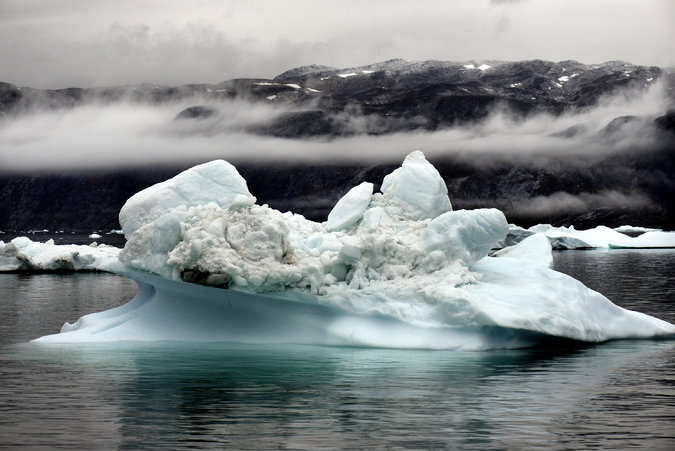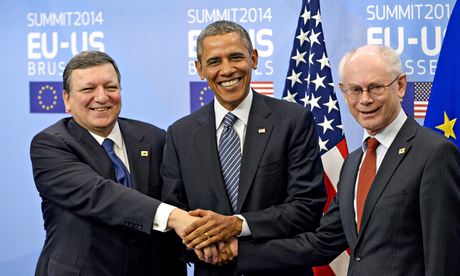Twitter: @evanlehmann | Email: elehmann@eenews.net
Evan Lehmann and Stephanie Paige Ogburn, E&E reporters
Published: Monday, March 31, 2014
The Obama administration’s effort to plug the nation’s methane leaks has rekindled the debate about the role of natural gas in national climate policy, with most environmentalists applauding the effort, while others describe it as an empty promise.
The White House announcement Friday was widely seen as an important step to stop emissions of methane, a strong greenhouse gas, at leaky wellheads, at pipelines and from flares at oil wells. The administration says its unfinished strategy could curb 90 million tons of greenhouse gases by 2020, a significant step toward President Obama’s goal of cutting emissions by 17 percent.
That would be achieved through potential regulations on the oil and gas sector, though U.S. EPA won’t know before this fall whether it will pursue new methane rules. The strategy also calls for plugging up leaks at coal mines, in landfills and on farms, using the gas instead for electricity generation.
“Reducing methane emissions is a powerful way to take action on climate change; and putting methane to use can support local economies with a source of clean energy that generates revenue, spurs investment and jobs, improves safety, and leads to cleaner air,” the 15-page strategy says.
But for some whose exclusive concern is climate change, the administration is trying to fix a problem of its own making. The administration wouldn’t need to fix methane leaks in the natural gas network if it hadn’t endorsed the development of hydraulic fracturing in the first place, said Bill McKibben, founder of 350.org.
“These guys have been encouraging the development of fracking all along, and now they’re trying to — I don’t know what they’re trying to do — make it not quite so bad,” he said. “This was a misguided idea to come up with a whole new source of hydrocarbons just at the moment when science was telling us we needed to get off hydrocarbons.”
He seems to represent a minority view, however, and last week, the president’s counselor, John Podesta, said that a fossil-free future was “impractical.”
“Methane is a potent heat-trapping pollutant, and we’ve long understood the urgency and importance of controlling it as a way to slow dangerous climate change,” David Doniger, director of the Climate and Clean Air Program at the Natural Resources Defense Council, said in a statement. He added that it’s “a big step in the right direction.”
Decision on regs this fall
Methane accounts for 9 percent of the nation’s greenhouse gas emissions, according to U.S. EPA. Much less methane is released annually than carbon dioxide. But the gas, known as CH4, is pound-for-pound about 21 times more efficient at trapping radiation in the atmosphere than CO2, making it a potent contributor to climate change.
The oil and gas industry is the single biggest source of methane, accounting for about 30 percent of emissions, according to EPA’s greenhouse gas inventory. The gas is sometimes flared from oil wells, when pipelines and other equipment used to capture and distribute the gas are absent. Some is also released during the production, storage and distribution of natural gas, of which methane is the key ingredient.
The switch from coal to natural gas is a significant driver behind the nation’s declining greenhouse gas emissions. But the benefit of using more gas, which releases about half the amount of emissions that coal does when burned, could be blunted if methane releases rise as hydraulic fracturing makes gas increasingly accessible for extraction, many environmentalists say.
The White House strategy states that EPA will solicit expert input this spring on significant sources of methane from the oil and gas sector, in white papers. Recently, a number of studies have been released showing that EPA estimates of methane emissions from natural gas activities are 50 percent lower than actual emissions measurements (ClimateWire, Feb. 14).
After the white papers are completed, the agency will decide this fall whether it should develop additional regulations to limit methane from oil and gas under its Clean Air Act authority. This could apply to both public and private lands, said Dan Utech, special assistant to the president for energy and climate change. If EPA pursues regulations, the rules would be completed by the end of 2016, just before Obama leaves office.
In response to the strategy release, industry groups focused on the progress made by voluntary programs and state-level regulations, which are also mentioned in the White House document.
The American Petroleum Institute released a statement saying more regulations would place an “unnecessary burden” on industry, which is voluntarily reducing emissions.
“Additional regulations are not necessary and could have a chilling effect on the American energy renaissance, our economy, and our national security,” API Director of Regulatory and Scientific Affairs Howard Feldman said in a statement.
Rules are the ‘only way’ to limit methane
The American Gas Association, which represents natural gas utilities, said it’s important to look at the most cost-effective way to reduce methane emissions over the entire natural gas production, distribution and use cycle.
Repairing natural gas infrastructure in cities can be an expensive way to plug leaks, but utilities are steadily working to do this, primarily with a focus on public safety, said Kathryn Clay, AGA’s vice president for policy strategy. Gas leaks can cause explosions.
“We look forward to continuing to work with the agencies, and we appreciate that the administration is taking a thoughtful, data-driven approach,” Clay said.
Environmental groups praised the strategy and the administration’s focus on methane, focusing on the potential for two significant rulemakings outlined in the document.
The Environmental Defense Fund, which has taken a leadership role in measuring the amount of methane leaking from the natural gas system, praised the announcement. Still, Eric Pooley, EDF’s senior vice president for strategy and communications, also said regulations were necessary to reduce emissions.
“We would call on EPA to go ahead and regulate methane from the oil and gas sector,” said Pooley.
Mark Brownstein, associate vice president and chief counsel of EDF’s U.S. Climate and Energy Program, said that while some gas companies have begun to address the issue of leaking methane, regulation would ensure that emissions are reduced.
“At the end of the day, the only way to be assured that everyone in industry will play by the same rules and that reductions will take place is when there is some kind of regulatory framework in place,” said Brownstein.
Landrieu breaks from Dems
The idea of regulating the booming gas industry, which is currently supplying U.S. markets with cheap fuel for electricity generation, is unappealing to at least one Democrat in a tight political election. Sen. Mary Landrieu (D-La.), the new chairwoman of the Committee on Energy and Natural Resources, said the strategy could harm her state.
“While I appreciate the administration’s efforts to develop a strategy to reduce methane gas emissions, I wish they put as much effort into developing a strategy to increase our domestic energy production,” Landrieu said in a statement. “I am concerned that the end result of these efforts will not be commonsense reform, but more of the same onerous regulations that hamper domestic production, hurt our farmers and kill jobs.”
One rule discussed in the strategy, informally referred to as Onshore Order 9, would revise the Bureau of Land Management’s policy on flaring and venting of methane from oil and gas extraction on federal land.
That policy has not been updated since 1980, and BLM is currently holding listening sessions in preparation for drafting a rule that would limit the amount of methane that is flared and vented from wells on public lands.
According to the strategy document, the agency will release that draft rule later this year.
“We’re hoping that BLM will issue tight restrictions on venting and flaring and require best management practices to stop leaks. We don’t think that an incentive-based or voluntary program is adequate to address the problem,” said Sarah Uhl, senior project director with the Clean Air Task Force.
More poop than cash
While agriculture is listed as a major source of human-related methane emissions in the United States, the reduction measures for that sector are entirely voluntary.
Those actions are focused around turning animal manure from large concentrated feeding operations into biogas energy.
Brian Murray, the director for economic analysis at Duke University’s Nicholas Institute for Environmental Policy Solutions and an expert on biogas from agriculture, said that biogas systems are very expensive. That has prevented farmers from adopting them.
“The capital expenditures necessary for a farmer to put in a digester are large, in the millions of dollars,” Murray said.
Without incentives to adopt the technology, farmers are unlikely to install such expensive methane digesting equipment on their farms. A voluntary system could work to increase adoption of methane digesters if farmers are given economic incentives through that system, said Murray.
Ultimately, the problem with curbing agricultural methane emissions is that since the sources are dispersed, it is still not very cost-effective to limit their methane emissions, he pointed out.
Twitter: @evanlehmann | Email: elehmann@eenews.net


